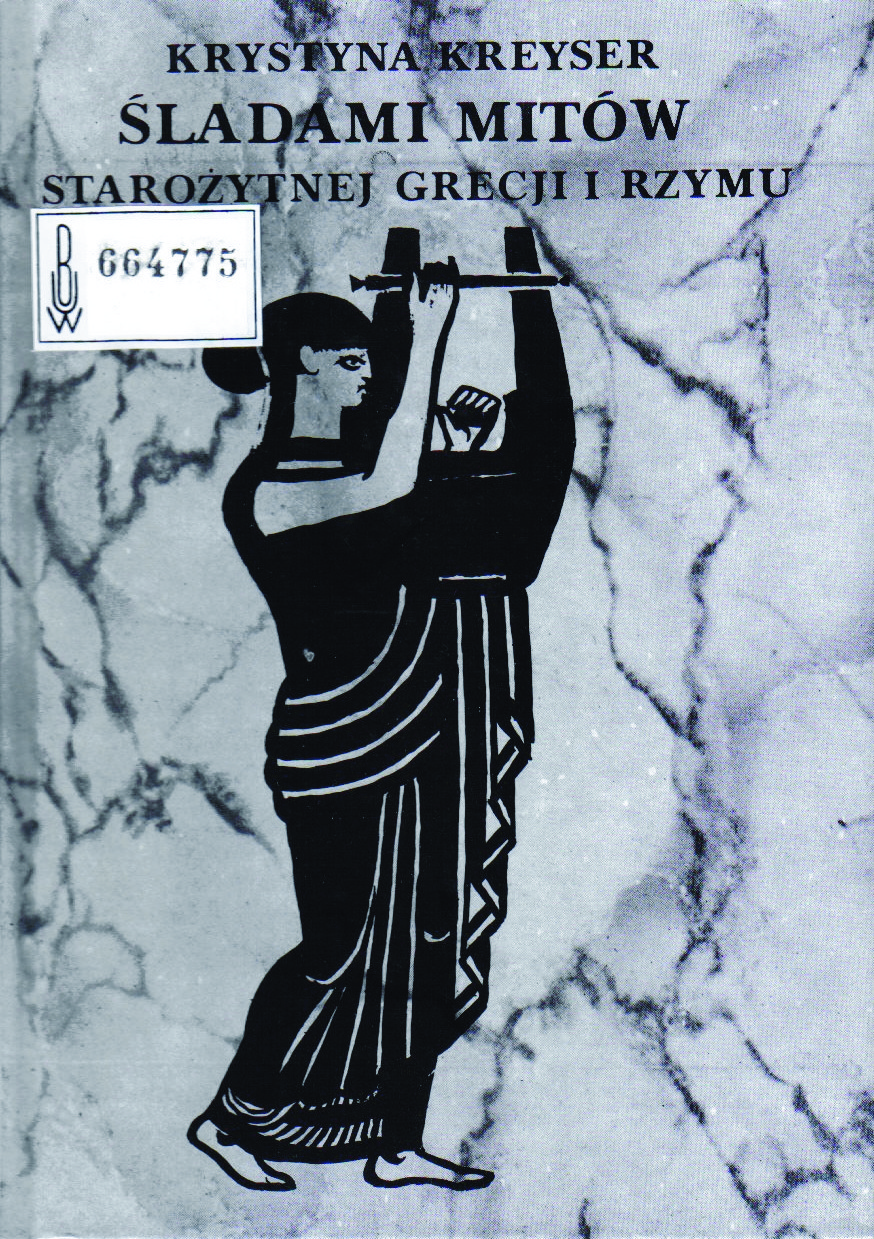Title of the work
Country of the First Edition
Country/countries of popularity
Original Language
First Edition Date
First Edition Details
Krystyna Kreyser, Śladami mitów starożytnej Grecji i Rzymu. Warszawa: Ludowa Spółdzielnia Wydawnicza, 1992, 240 pp.
ISBN
Genre
Educational stories*
Target Audience
Crossover (Older children, teenagers, young adults)
Cover

Graphic design by Stanisław Kaźmierczyk. Courtesy of the publisher.
Author of the Entry:
Summary: Barbara Krcha, University of Warsaw, krcha@student.uw.edu.pl
Analysis: Marta Pszczolińska, University of Warsaw, m.pszczolinska@al.uw.edu.pl
Peer-reviewer of the Entry:
Katarzyna Marciniak, University of Warsaw, kamar@al.uw.edu.pl
Elżbieta Olechowska, University of Warsaw, elzbieta.olechowska@gmail.com

Photograph courtesy of Piotr Kreyser, the Author’s Son.
Krystyna Kreyser
, 1924 - 2009
(Author)
Classical philologist (PhD), president of the Section of Popularization of the Knowledge about Antiquity, Polish Philological Association (PTF). Initiator of high school Olympics rewarding knowledge of Antiquity, under the patronage of the PTF; member of the Polish Veterinary Society; Latin teacher; author and co-author of many books and of over 150 articles about the influence of Antiquity on European culture and on teaching Latin. Awarded the Rector’s 1st prize for didactic achievements at the Warsaw University of Life Sciences (SGGW). Main works: Śladami mitów starożytnej Grecji i Rzymu [Following the Myths of Ancient Greece and Rome], 1992; Cztery pory roku w mitach Greków i Rzymian [Four Seasons in the Myths of the Greeks and Romans], 1993; Zwierzęta gospodarskie w traktatach agrarnych pisarzy rzymskich I wieku cesarstwa [Farm Animals in Agrarian Treatises of Roman Writers of the 1st Century of the Empire], 1996; Tabella. Łacina bez trudu [Tabella. Latin Without Effort], 2006. Co-author with Halina Cieszkowska of: Gaudium in litteris, czyli radość z odczytywania napisów. Przechadzki po Warszawie [Gaudium in litteris, or the Joy of Reading Inscriptions. Walks through Warsaw], 1993; Wizytówki Warszawy [Vigniettes of Warsaw], 2000.
Source:
Bio based on the material kindly provided by the Author’s Son.
Bio prepared by Barbara Krcha, University of Warsaw, krcha@student.uw.edu.pl
Summary
Based on: Katarzyna Marciniak, Elżbieta Olechowska, Joanna Kłos, Michał Kucharski (eds.), Polish Literature for Children & Young Adults Inspired by Classical Antiquity: A Catalogue (accessed: June 16, 2021), Faculty of “Artes Liberales”, Warsaw: University of Warsaw, 2013, 444 pp., section by Barbara Krcha, pp. 150–152.
The stories explain how Greek and Roman myths are reflected in the order of the world, natural phenomena, and in the calendar. The author discusses ancient origin of widely used names, expressions and popular Latin and Polish phrases. There are many tales about mythical characters connected to plants and animals. There is also an explanation of stars and signs of zodiac identified with gods and gods’ favourites who have been put among the stars. Another story discusses the origins of the calendar and names of the days of the week, and of the months. A group of tales is associated with geographical sites, another is specially dedicated to medicine. Medical terms are related to Greek and Roman myths. All the tales demonstrate the influence of mythology and ancient customs on modern culture, medicine, art, and everyday life.
Analysis
Here, Greek myths are considered to be explanations of natural phaenomena of the surrounding world and an expression of understanding the world by ancient Greeks. The author reveals mythical Greek and Roman images in science, art, music and common language, demonstrating that the ancient past is part of contemporary life. Her narrative strategy combines the language of storytelling and scientific information. The book is divided into eight chapters. Each of them shows our mythical inheritance in another area: astronomy, calendar and time issues, phaenomena of nature, chemistry, botany and zoology, geography, medicine and others, for instance, myths perpetuated in the language. At the end, the author provides a bibliography including ancient sources and an index of names with short descriptions of each character or place mentioned.
In the first chapter, Kreyser evokes Greek myths connected to the stars and constellations named after mythical characters, animals and objects. The importance of these stellar myths is confirmed by the description of Achilles’ shield in the Iliad. Knowledge of stars from the earliest times was a significant part of life for the Greeks, as it allowed orientation and navigation and produced astro-science. Star mythology is still present in the contemporary world of science and culture. Kreyser chose many stars, 25 constellations, zodiacs, planets and planetoids to make the reader aware of the ancient roots of today’s skyscapes.
The second chapter is dedicated to the measurement of time. It seems to review facts rather than introduce retellings of particular myths, although the information provided is deeply rooted in Roman culture. The next chapter presents myths explaining natural phaenomena, such as the seasons, wind, volcanoes and seismic activity: the myth of Persephone, Aeolus, and Typhon. Chapter four lists chemical elements named after mythical characters. Chapter five presents plants and animals to, in a way, combine botanical/zoological descriptions, sometimes also their use, and origin of the name along with the connected myth. As most of the animals presented here are mentioned by Ovid in his Metamorphoses, the author quotes fragments of translations concerning the moment of transformation. Chapter six presents geographical names originating in Greek mythology. Chapter seven follows the Greek roots of medical terms, including the Asclepius’ myth, anatomical terminology, names of diseases, surgical procedures or some drugs/medications.
The last chapter, entitled Varia, follows the other examples of Greek myths in everyday life, especially their traces in vocabulary. This chapter is the longest and provides information most useful in the educational process, necessary to understand many important words, terms, phrasal verbs, proverbs and sentences, and explains where they come from and how to understand and use them properly.
Further Reading
Kreyser, Krystyna, Tabella. Łacina bez trudu, Warszawa: Wiedza Powszechna, 2006.


